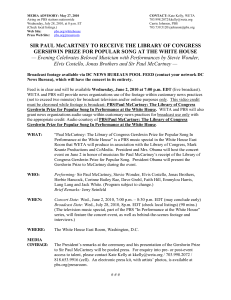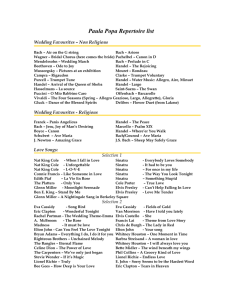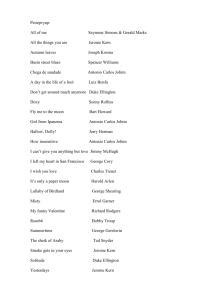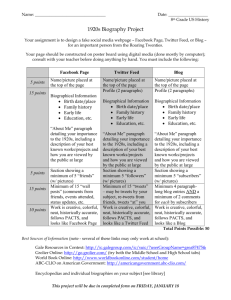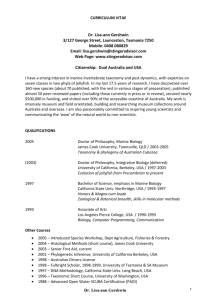A. Briseno - Pegasus @ UCF
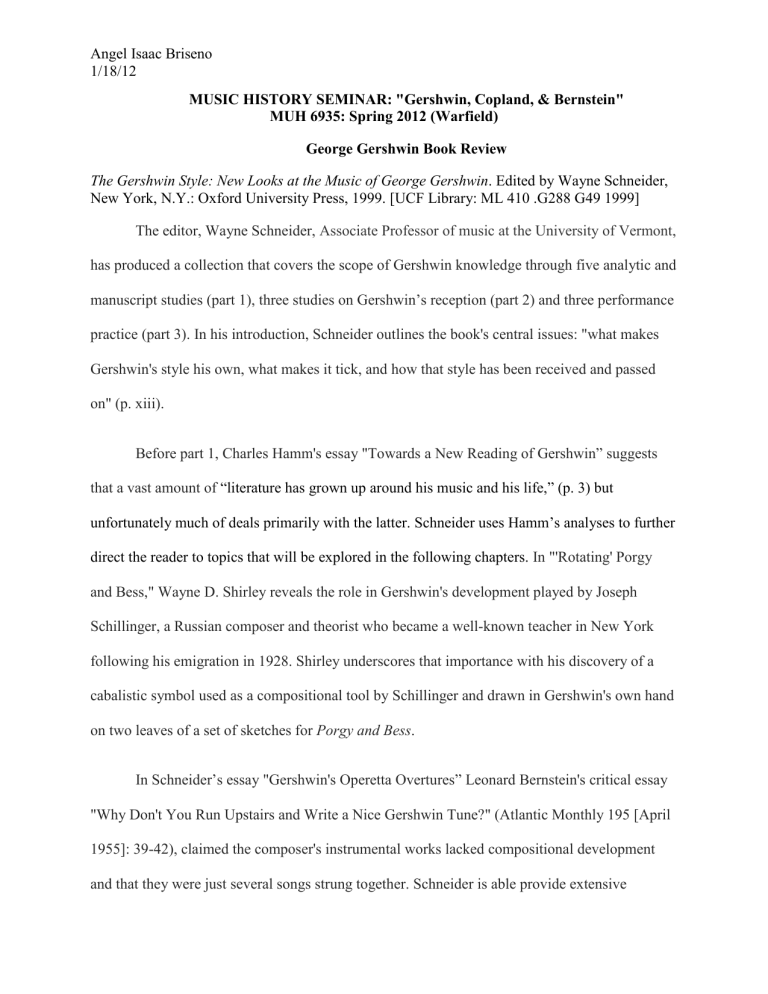
Angel Isaac Briseno
1/18/12
MUSIC HISTORY SEMINAR: "Gershwin, Copland, & Bernstein"
MUH 6935: Spring 2012 (Warfield)
George Gershwin Book Review
The Gershwin Style: New Looks at the Music of George Gershwin . Edited by Wayne Schneider,
New York, N.Y.: Oxford University Press, 1999. [UCF Library: ML 410 .G288 G49 1999]
The editor, Wayne Schneider, Associate Professor of music at the University of Vermont , has produced a collection that covers the scope of Gershwin knowledge through five analytic and manuscript studies (part 1), three studies on Gershwin’s reception (part 2) and three performance practice (part 3). In his introduction, Schneider outlines the book's central issues: "what makes
Gershwin's style his own, what makes it tick, and how that style has been received and passed on" (p. xiii).
Before part 1, Charles Hamm's essay "Towards a New Reading of Gershwin” suggests that a vast amount of “literature has grown up around his music and his life,” (p. 3) but unfortunately much of deals primarily with the latter. Schneider uses Hamm’s analyses to further direct the reader to topics that will be explored in the following chapters. In "'Rotating' Porgy and Bess," Wayne D. Shirley reveals the role in Gershwin's development played by Joseph
Schillinger, a Russian composer and theorist who became a well-known teacher in New York following his emigration in 1928. Shirley underscores that importance with his discovery of a cabalistic symbol used as a compositional tool by Schillinger and drawn in Gershwin's own hand on two leaves of a set of sketches for Porgy and Bess .
In Schneider’s essay "Gershwin's Operetta Overtures” Leonard Bernstein's critical essay
"Why Don't You Run Upstairs and Write a Nice Gershwin Tune?" (Atlantic Monthly 195 [April
1955]: 39-42), claimed the composer's instrumental works lacked compositional development and that they were just several songs strung together. Schneider is able provide extensive
Angel Isaac Briseno
1/18/12 harmonic analysis of the overtures to Of Thee I Sing and Let 'Em Eat Cake . He also goes on to refute Bernstein’s opinion by stating “Gershwin’s counterpoint, “modernistic” harmony, and other positional devices in the connective tissues of the potpourri overture to Girl Crazy and especially the dramatic overtures to Of Thee I Sing and
Let ‘Em Eat Cake
show his musical thinking to be conscious, purposeful, clever.” (p. 62)
Stephen E. Gilbert's essay "Nice Work: Thoughts and Observations on Gershwin's Late
Songs" offers an examining of Gershwin’s accompaniment style, counterpoint, key selection, harmony, as well as Schillinger's influence. Larry Starr's donation, "Musings on 'Nice Gershwin
Tunes,' Form, and Harmony in the Concert Music of Gershwin," reopens the previously mentioned Bernstein essay to remind readers that Gershwin "has been a suspect figure in the world of 'serious' music" (p. 95). After defining what a "tune" is, Starr offers that the melodies of
An American in Paris and Rhapsody in Blue as proof of the "tuneful" music and “unsatisfactory pop tunes.” Concluding the first section is John Andrew Johnson’s "Gershwin's
Blue Monday
(1922) and the Promise of Success," in which he shows the similarities and differences between this early "Opera Ala Afro-American" and Porgy and Bess . He persuasively establishes Blue
Monday as “pivotal in his compositional maturation” (p. 129) through analysis as well as various reviews and sources of the performances. One of the predecessors of Porgy and Bess, Blue
Monday “is a failed experiment, yes, but bold-like-genius, and without it his later greater contributions” would not have been such a success.
The three reception essays in part 2 create a different viewpoint from the previous essays.
Charlotte Greenspan offers approval of the film Rhapsody in Blue: The Story of George
Gershwin . Although “many facts about Gershwin’s career are presented accurately” (p. 147)
Edward Jablonski and Lawrence Stewart stated that the movie was highly romanticized “[at a
Angel Isaac Briseno
1/18/12 time] when the world needed escape, romance, and music.” (p. 145). Greenspan goes on to suggest “the complex mixture of motives that went into [the] creation” of this hagiographical film. In what seems at first to be a far-fetched comparison, Susan Richardson compares
Gershwin and rock stars in "Gershwin on the Cover of Rolling Stone." She reveals the Gershwin tunes within such notables as Elton John, Jon Bon Jovi, and Cher. She also parallels the composer's wealth and fame to current music stars where “Gershwin was a genuinely and uniquely American phenomenon, more than the sum of its parts.” In the final essay of this section, C. André Barbera studies Gershwin's relationship to African American jazz. A wellwritten article with analyses of rhythm, melody, harmony and phrasing or structure is lessened by the constant negative connotations of jazz only as the art and music of “black American creation” as well as by the allegation that Gershwin's appropriation of black music was an effort
"to steal the soul of the oppressed" (p. 177).
Part 3 begins with Artis Wodehouse's essay tracing the history of Gershwin's piano rolls, issued from 1915 to 1925 which he “successfully negotiated the increasingly challenging hurdles of the music industry to become a commercially successful songwriter and achieve worldwide recognition.” (p. 209) Coupled with the previous essay, Michael Montgomery presents the
"Piano Rollography" ("an annotated and classified list of an artist's piano roll recordings" (p.
225)) and chronologically catalogs Gershwin's list of rolls with accuracy. Edward Jablonski ends the volume with his essay on events in Ira Gershwin's life, including his collaborations with
Jerome Kern, Kurt Weill, and Harold Arlen in chronological order. Although for many years, Ira lived in the shadow of his younger brother, Jablonski is able to enlighten the reader that with “a unique blend of scholarly craftsmanship, gentle whimsy, a sharp eye and ear, and, yes, [poetry]”
Ira was able create his own path after the death of George.
Angel Isaac Briseno
1/18/12
In this refreshing collection of essays, Schneider reached his purpose. Similar to what
Schneider stated about Gershwin “there is method here, not a casual stringing together of songs; there is, in short, composition.” (p. 62) Schneider was able to create new looks at the music of
George Gershwin far beyond his life.
By Angel Isaac Briseno
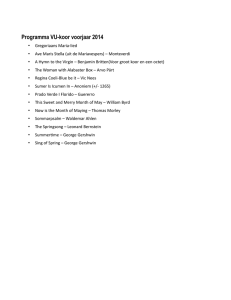
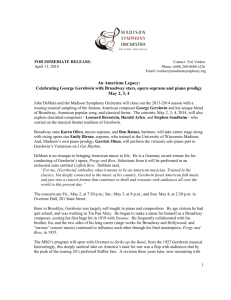

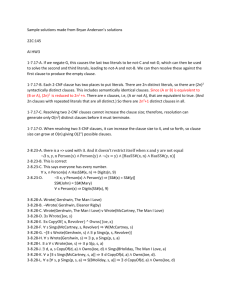
![[On Gershwin joining the mainstream repertoire] An Upstart Named](http://s3.studylib.net/store/data/008079569_1-6b9198adb3eab7f9de6809757d5ed4ac-300x300.png)
